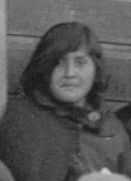Alice Piper facts for kids
Quick facts for kids
Alice Piper
|
|
|---|---|

Alice Piper, (~age 15) standing in front of the Paiute Community Center, c. early 1920s
|
|
| Born | September 7, 1908 |
| Died | August 22, 1985 (aged 76) |
| Citizenship | Paiute |
| Known for | Early US civil rights hero |
Alice Piper (born September 7, 1908 – died August 22, 1985) was a brave Paiute (Nüümü) woman. When she was a teenager, she fought for her right to get a good education.
In 1923, Alice lived in Big Pine, California. She wanted to attend the new Big Pine High School. But she was not allowed to go because she was Native American. At that time, a California law said Native American children could not attend public schools. This was true if there was a separate government-run "Indian school" nearby.
Alice and six other Native American children decided to take action. They sued the school district. Alice argued that her rights under the 14th Amendment were being ignored. This amendment promises equal protection for all citizens. She knew the "Indian school" was not as good as the public high school. The local Indian day school only taught up to the 5th grade. It also did not have enough money or supplies.
The school leaders had even made a promise. They said Native American students could attend if their parents voted for a school building fund. The parents voted yes, but the leaders did not keep their word. A local person remembered the day Alice asked to join the school. "All the mothers and fathers, both Native American and white, were there," they said. "When the school said no, the Native Americans immediately went to court." They filed the case in Alice Piper's name.
The California Supreme Court agreed with Alice. They ruled in her favor in the case Piper v. Big Pine (1924). This important decision meant that Alice and other Native American children could attend public schools in California.
Why Alice Piper is Important
Alice Piper's court win was a big step forward for Native American education. It stopped the practice of sending Native American children to separate, less-funded schools. This was true even if they were ready for public school.
The Piper v. Big Pine case was later used as an example. Chief Justice Warren mentioned it in the famous Brown v. Board of Education ruling in 1954. That ruling ended segregated schools across the United States.
Alice Piper is seen as an early civil rights hero. She fought for equal chances in education for Native Americans. Her actions helped open doors for all children to get a fair education, no matter their background. Ada Wardle Robinson, a school official, later said, "We are reminded that all young citizens can learn and grow. We are thankful to those Native Americans who insisted their children get an equal chance."
Honoring Alice Piper's Fight
In 2009, the Big Pine Paiute Tribe and the Big Pine Unified School District made an agreement. They decided to honor Alice Piper's victory. They planned to place a statue of her in front of the school.
The statue was officially revealed on June 2, 2014. This date was the 90th anniversary of Alice Piper's court win. It was placed right where the school leaders had denied her entry in 1923. This date also marks another important event. On June 2, 1924, President Grover Cleveland signed the Indian Citizenship Act. This law made all Native Americans citizens of the United States.
As of 2014, more than half of the students at Big Pine High School are Native American. This shows the lasting impact of Alice Piper's fight for equality.
See also
 In Spanish: Alice Piper para niños
In Spanish: Alice Piper para niños


